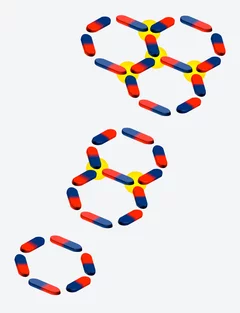Scientists use nano-rods to investigate how matter assembles
In the microscopic world, everything is in motion: atoms and molecules vibrate, proteins fold, even glass is a slow flowing liquid. And during each movement there are interactions between the smallest elements - for example, the atoms - and their neighbours. To make these movements visible, scientists at the Paul Scherrer Institute PSI have developed a special model system. It is so big that it can be easily observed under an X-ray microscope, and mimics the tiniest movements in Nature. The model: rings made from six nanoscale magnetic rods, whose north and south poles attract each other. At room temperature, the magnetisation direction of each of these tiny rods varies spontaneously. Scientists were able to observe the magnetic interactions between these active rods in real time. These research results were published on May 5 in the journal Nature Physics
.
Read the full story
Reference
Exploring hyper-cubic energy landscapes in thermally active finite artificial spin-ice systemsA. Farhan, M. Derlet, A. Kleibert, A. Balan, R. V. Chopdekar, M. Wyss, L. Anghinolfi, F. Nolting & L. J. Heyderman
Nature Physics, Volume: 9, pages: 375-382 (2013), advance online publication 05 May 2013, DOI:10.1038/nphys2613
Contact
Prof. Dr. Laura Jane Heyderman, Laboratory for Micro- und NanotechnologyPaul Scherrer Institute, 5232 Villigen PSI, Switzerland
Phone: +41 56 310 26 13, e-mail: laura.heyderman@psi.ch
Dr. Peter Derlet, Solid State Theory Group
Paul Scherrer Institut, 5232 Villigen PSI, Switzerland
Phone: +41 56 310 31 64, e-mail: peter.derlet@psi.ch
